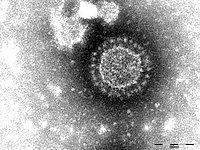
Photo from wikipedia
Porcine epidemic diarrhea is an acute, highly contagious enteric viral disease severely affecting the pig industry, for which current vaccines are inefficient due to the high variability of PEDV. Because… Click to show full abstract
Porcine epidemic diarrhea is an acute, highly contagious enteric viral disease severely affecting the pig industry, for which current vaccines are inefficient due to the high variability of PEDV. Because PEDV infection can lead to severe injury of the intestinal epithelial barrier, which is the first line of defense, a better understanding of the related mechanisms may facilitate the development of new strategies for the prevention and treatment of PED. ABSTRACT Porcine epidemic diarrhea (PED) is a highly contagious disease, caused by porcine epidemic diarrhea virus (PEDV), which causes huge economic losses. Tight junction-associated proteins play an important role during virus infection; therefore, maintaining their integrity may be a new strategy for the prevention and treatment of PEDV. Long noncoding RNAs (lncRNAs) participate in numerous cellular functional activities, yet whether and how they regulate the intestinal barrier against viral infection remains to be elucidated. Here, we established a standard system for evaluating intestinal barrier integrity and then determined the differentially expressed lncRNAs between PEDV-infected and healthy piglets by lncRNA-seq. A total of 111 differentially expressed lncRNAs were screened, and lncRNA446 was identified due to significantly higher expression after PEDV infection. Using IPEC-J2 cells and intestinal organoids as in vitro models, we demonstrated that knockdown of lncRNA446 resulted in increased replication of PEDV, with further damage to intestinal permeability and tight junctions. Mechanistically, RNA pulldown and an RNA immunoprecipitation (RIP) assay showed that lncRNA446 directly binds to ALG-2-interacting protein X (Alix), and lncRNA446 inhibits ubiquitinated degradation of Alix mediated by TRIM25. Furthermore, Alix could bind to ZO1 and occludin and restore the expression level of the PEDV M gene and TJ proteins after lncRNA446 knockdown. Additionally, Alix knockdown and overexpression affects PEDV infection in IPEC-J2 cells. Collectively, our findings indicate that lncRNA446, by inhibiting the ubiquitinated degradation of Alix after PEDV infection, is involved in tight junction regulation. This study provides new insights into the mechanisms of intestinal barrier resistance and damage repair triggered by coronavirus. IMPORTANCE Porcine epidemic diarrhea is an acute, highly contagious enteric viral disease severely affecting the pig industry, for which current vaccines are inefficient due to the high variability of PEDV. Because PEDV infection can lead to severe injury of the intestinal epithelial barrier, which is the first line of defense, a better understanding of the related mechanisms may facilitate the development of new strategies for the prevention and treatment of PED. Here, we demonstrate that the lncRNA446 directly binds one core component of the actomyosin-tight junction complex named Alix and inhibits its ubiquitinated degradation. Functionally, the lncRNA446/Alix axis can regulate the integrity of tight junctions and potentially repair intestinal barrier injury after PEDV infection.
Journal Title: Journal of Virology
Year Published: 2023
Link to full text (if available)
Share on Social Media: Sign Up to like & get
recommendations!